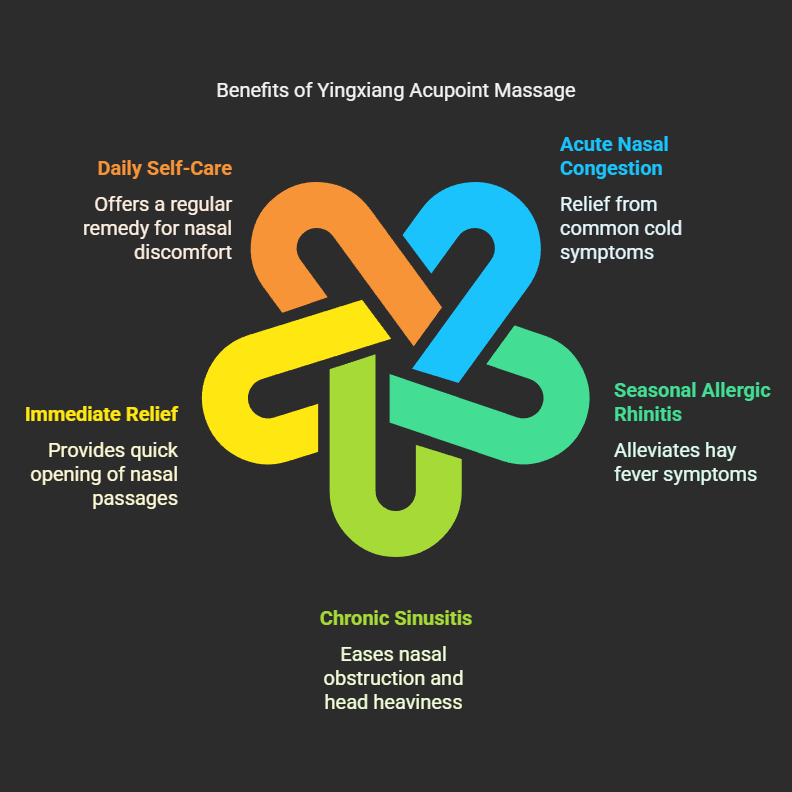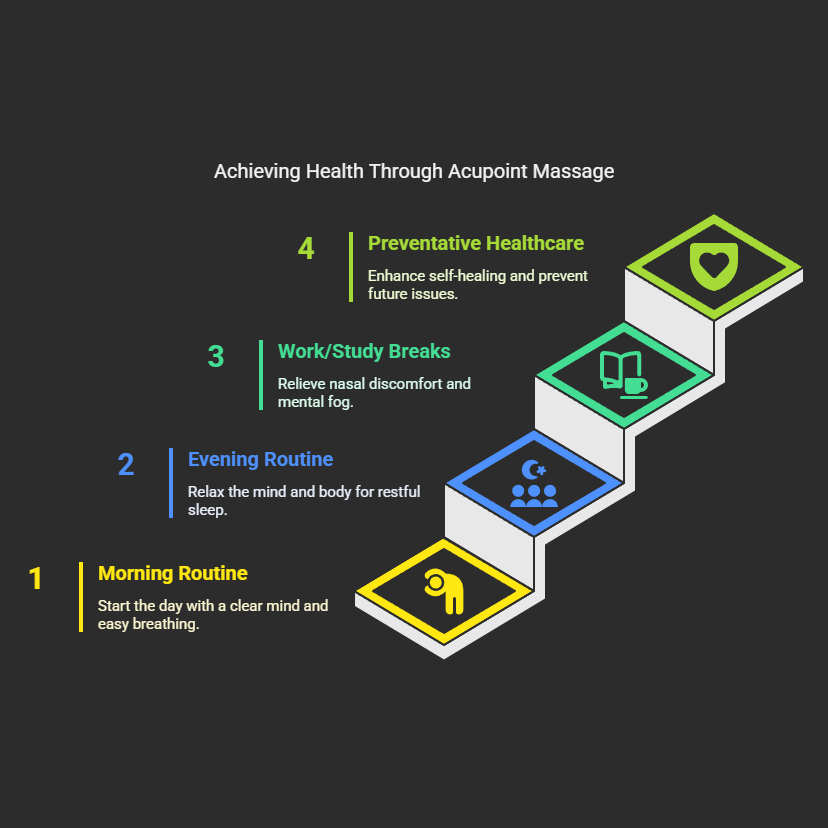Hello everyone, I am your Massage Therapist. In our hectic modern lives, pursuing a 'Happy Healthy Life' – a state of being healthy, happy, and full of vitality – has become a common goal for many.However, have you ever felt your quality of life diminished by seemingly minor annoyances like nasal congestion, seasonal allergies, or chronic rhinitis? Clear breathing is fundamental to mind-body health. When your nasal passages are blocked, it not only disrupts sleep and lowers daytime energy levels but can also cause you to miss out on many of life's wonderful aromas.Today, I want to share with you a simple yet remarkably powerful self-care method from Traditional Chinese Medicine (TCM) – massaging the Yingxiang acupoint (LI20). Think of it as an important gateway to clearer breathing and embracing your 'Happy Healthy Life'.
Exploring Yingxiang (LI20) – Your Face's Breathing Code
To unleash the amazing effects of the Yingxiang acupoint (LI20), accurately locating it is the first crucial step. The Yingxiang acupoint is located on your face, in the depression where the nasolabial groove (your smile line) meets a horizontal line drawn from the widest part of your nostril (ala nasi).Looking in a mirror and smiling slightly can help make this groove more distinct for easier location. Gently press this spot with the pad of your index or middle finger; you'll typically feel a slight depression or notice that the area is particularly sensitive to pressure.Yingxiang is a bilateral acupoint, meaning there's one on each side of the nose. For best results, it's recommended to stimulate both points simultaneously during massage. The poetic name of this acupoint, 'Welcome Fragrance' (Yingxiang), directly highlights its core function: to help restore a keen sense of smell and clear the nasal passages.
Massaging Yingxiang (LI20): Multiple Benefits for Your Respiratory System
The most acclaimed effect of the Yingxiang acupoint (LI20) is its excellent ability to clear the nasal passages. Whether it's acute nasal congestion from a common cold, seasonal allergic rhinitis (hay fever – typically causing sneezing, a clear runny nose, and an itchy nose), or nasal obstruction and a heavy head associated with chronic sinusitis, massaging the Yingxiang acupoint can provide significant relief.Many people, after massaging the point correctly, can immediately feel their nasal passages open up and their breathing become easier, as if a window has been opened for a congested airway. This immediate soothing effect makes the Yingxiang acupoint an excellent daily self-care remedy for many sufferers of nasal discomfort, helping them to overcome their issues and rediscover the freedom of easy breathing.

From a Traditional Chinese Medicine (TCM) theory perspective, symptoms like nasal congestion and runny nose often arise from the invasion of 'external pathogenic factors' (Wai Xie), such as Wind-Cold or Wind-Heat. They can also stem from dysfunction of internal Zang-Fu organs like the Lung, Spleen, and Kidney, leading to impeded Qi and Blood circulation and impaired function of the nasal passages.The Yingxiang acupoint (LI20) is located at the end point of the Hand Yangming Large Intestine Meridian. This meridian is exteriorly-interiorly related to the Lung Meridian, indicating a close functional connection. According to TCM, 'the Lung governs respiration and opens into the nose.' Therefore, the clarity of the nasal passages directly reflects the diffusing and descending functions of Lung Qi.Massaging the Yingxiang acupoint helps clear meridian Qi and Blood in the head and face. This aids in dispelling Wind and pathogenic factors and promoting the free flow of Lung Qi, thereby restoring the normal physiological function of the nasal passages and improving troublesome nasal symptoms.
Besides directly improving nasal symptoms, massaging the Yingxiang acupoint (LI20) also helps to promote facial blood circulation. As acupoint stimulation promotes local Qi and Blood flow, consistent long-term massage can lead to better nourishment for the facial skin, resulting in a rosier and more radiant complexion; this is also a natural beauty method.Furthermore, for referred pain or a feeling of pressure in the forehead, cheeks, or even the gums, stemming from sinus pressure or nasal congestion, the Yingxiang acupoint also serves as an effective point for relief. While complex conditions such as facial paralysis necessitate professional medical attention, ancient texts also document its regulatory influence on facial nerve function, highlighting its benefits for overall facial health.
Practical Yingxiang (LI20) Acupressure: Simple Steps, Easy to Lear
Before performing Yingxiang acupoint (LI20) massage, please ensure your hands are clean. You can adopt a comfortable sitting or lying posture, ensuring your mind and body are relaxed. If you have excessive nasal discharge (a very runny nose), you might want to gently blow your nose first.After locating the Yingxiang acupoint, the massage is typically performed using the pad of your index or middle finger. The pressure should be such that you feel a mild aching or distending sensation (often referred to as 'Deqi' or the arrival of Qi in TCM), but it must not cause sharp pain. This sensation indicates the acupoint has been effectively stimulated.You can use gentle circular motions, rubbing or kneading clockwise and then anti-clockwise for about 30 circles in each direction. Alternatively, employ a pressing technique: apply pressure either deep into the acupoint or slightly angled towards the root of your nose. Hold for 5-10 seconds, then slowly release, repeating this 10-15 times.

Regarding the duration and frequency of massage, it is generally recommended to massage the Yingxiang acupoint (LI20) for 1 to 3 minutes each time. For acute nasal congestion, such as during the early stages of a cold, you can massage it 2 to 3 times daily, or even whenever you feel nasal discomfort.If you are addressing chronic rhinitis or allergic rhinitis, persistence is paramount. It's advisable to massage the point once in the morning and once in the evening, incorporating it into your daily health routine. Consistent acupoint massage is essential to better experience its long-term benefits of regulating bodily functions, and preventing and alleviating discomfort.Remember, acupoint massage is a gentle, natural therapy, and its effects build up over time with patience.
Although Yingxiang acupoint (LI20) massage is generally safe, there are still some situations that require caution. Avoid massaging areas where the skin is broken, inflamed, red and swollen, or has an acute rash.If you have a bleeding disorder or are taking anticoagulant medication (blood thinners), please consult your doctor (GP) for professional advice before trying acupoint massage.For pregnant women: while the Yingxiang acupoint itself isn't explicitly contraindicated during pregnancy, any acupoint stimulation during this time should be approached with extreme caution. It is advisable to consult your TCM practitioner or obstetrician first. This is particularly crucial if planning to combine it with other acupoints (like Hegu LI4), as their specific contraindications must be understood – Hegu, for instance, is contraindicated for pressure during pregnancy.
Synergistic Enhancement: Yingxiang (LI20)'s 'Golden Partners' and Lifestyle Adjustments
In Traditional Chinese Medicine (TCM) practice, using acupoints in combination can often produce a synergistic effect where '1+1 is greater than 2'. For nasal problems, the Yingxiang acupoint (LI20) has several common 'partners'.For example, the Hegu acupoint (LI4), located in the 'tiger's mouth' (the web between the thumb and index finger) on both hands, is the Yuan-Source point of the Large Intestine Meridian. It is lauded with the TCM saying 'For face and mouth problems, Hegu addresses them' (Miàn Kǒu Hégǔ Shōu) and has excellent effects on many head and face discomforts, being particularly good at stopping pain and clearing heat.The Yintang acupoint (EX-HN3), found at the midpoint of the line connecting the inner ends of your eyebrows, can calm the Shen (Spirit), settle fright, clear the head, brighten the eyes, open the nasal passages, and clear the orifices (key sensory openings). Combining massage of Yingxiang (LI20) with these two acupoints can more comprehensively improve discomfort in the nasal passages and the head and face area.However, please note: due to its strong effect in promoting Qi flow and invigorating blood, acupressure on Hegu (LI4) must be avoided during pregnancy.
Besides acupoint synergy, combining massage of the Yingxiang acupoint (LI20) with breathing exercises and dietary adjustments can further consolidate its effects and promote a 'Happy Healthy Life'.You can try deep, long abdominal breathing: slowly inhale through your nose, feeling your abdomen gently expand; then slowly exhale through your mouth or nose, expelling any stale air. Such breathing exercises help to enhance lung function and calm the mind (Shen).In terms of diet, for those prone to nasal discomfort, it's advisable to reduce consumption of raw, cold, pungent, and stimulating foods. Also, limit foods known in TCM to generate 'phlegm and dampness', such as excessive sweets and dairy products. Maintaining a balanced diet rich in fresh fruits and vegetables, and making adjustments based on your individual 'cold' or 'heat' constitution (a TCM concept), is vital for preserving nasal health.
Integrating Yingxiang (LI20) into Your Daily Routine: Moving Towards a 'Happy Healthy Life
Integrating massage of the Yingxiang acupoint (LI20) into your daily life is actually very simple. You can gently press it for a few minutes after waking in the morning to help clear your head and begin a day of easy breathing; or you can do it after your evening skincare routine as a step to relax your mind and body and prepare for a restful night's sleep.During work or study breaks, if you feel nasal discomfort or your head feels muddled, a quick massage of the Yingxiang acupoint can also bring immediate relief. The key is consistency, turning this simple action into a beneficial health habit.This aligns with the Traditional Chinese Medicine (TCM) concept of 'Zhi Wei Bing' (Preventative Healthcare or 'Treating Pre-disease'). Regular acupoint care can not only alleviate existing symptoms but also help prevent future issues and enhance the body's natural self-healing capabilities.

Conclusion: Embrace Yingxiang (LI20 – Welcome Fragrance) and Discover 'Happy Healthy' Wellbeing in Every Breat
In conclusion, although the Yingxiang acupoint (LI20) is small, it is a radiant pearl in the treasure trove of Traditional Chinese Medicine (TCM) wisdom. Through simple self-massage, we can not only effectively clear our nasal passages, relieve common issues like nasal congestion and allergies, and regain the refreshing ease of uninhibited breathing, but also indirectly promote facial Qi and Blood circulation, adding natural vitality and radiance to our 'Happy Healthy Life'.All this can be easily achieved with our own hands, fully embodying the core TCM healthcare principles of being 'simple, convenient, inexpensive, and effective'.I hope today's sharing has deepened your understanding of the Yingxiang acupoint and inspired you to willingly integrate this method into your daily routine. May you, with the Yingxiang acupoint as your companion, breathe freshly every day, be full of vitality, and truly achieve a 'Happy Healthy Life' of mind-body harmony!
